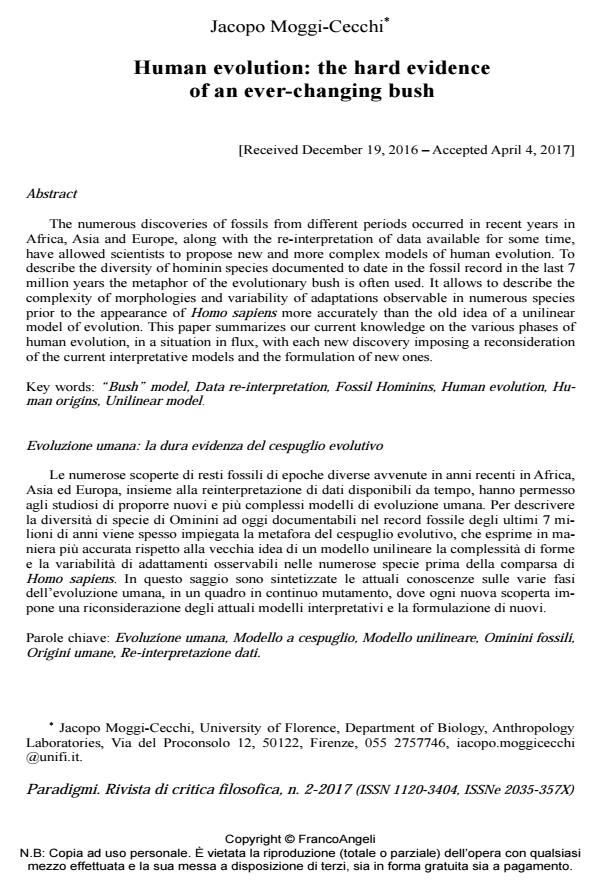Human evolution: the hard evidence of an ever-changing bush
Titolo Rivista PARADIGMI
Autori/Curatori Jacopo Moggi-Cecchi
Anno di pubblicazione 2017 Fascicolo 2017/2
Lingua Inglese Numero pagine 23 P. 89-111 Dimensione file 285 KB
DOI 10.3280/PARA2017-002007
Il DOI è il codice a barre della proprietà intellettuale: per saperne di più
clicca qui
Qui sotto puoi vedere in anteprima la prima pagina di questo articolo.
Se questo articolo ti interessa, lo puoi acquistare (e scaricare in formato pdf) seguendo le facili indicazioni per acquistare il download credit. Acquista Download Credits per scaricare questo Articolo in formato PDF

FrancoAngeli è membro della Publishers International Linking Association, Inc (PILA)associazione indipendente e non profit per facilitare (attraverso i servizi tecnologici implementati da CrossRef.org) l’accesso degli studiosi ai contenuti digitali nelle pubblicazioni professionali e scientifiche
The numerous discoveries of fossils from different periods occurred in recent years in Africa, Asia and Europe, along with the re-interpretation of data available for some time, have allowed scientists to propose new and more complex models of human evolution. To describe the diversity of hominin species documented to date in the fossil record in the last 7 million years the metaphor of the evolutionary bush is often used. It allows to describe the complexity of morphologies and variability of adaptations observable in numerous species prior to the appearance of Homo sapiens more accurately than the old idea of a unilinear model of evolution. This paper summarizes our current knowledge on the various phases of human evolution, in a situation in flux, with each new discovery imposing a reconsideration of the current interpretative models and the formulation of new ones.
Le numerose scoperte di resti fossili di epoche diverse avvenute in anni recenti in Africa, Asia ed Europa, insieme alla reinterpretazione di dati disponibili da tempo, hanno permesso agli studiosi di proporre nuovi e più complessi modelli di evoluzione umana. Per descrivere la diversità di specie di Ominini ad oggi documentabili nel record fossile degli ultimi 7 milioni di anni viene spesso impiegata la metafora del cespuglio evolutivo, che esprime in maniera più accurata rispetto alla vecchia idea di un modello unilineare la complessità di forme e la variabilità di adattamenti osservabili nelle numerose specie prima della comparsa di Homo sapiens. In questo saggio sono sintetizzate le attuali conoscenze sulle varie fasi dell’evoluzione umana, in un quadro in continuo mutamento, dove ogni nuova scoperta impone una riconsiderazione degli attuali modelli interpretativi e la formulazione di nuovi.
Parole chiave:Evoluzione umana, Modello a cespuglio, Modello unilineare, Ominini fossili, Origini umane, Re-interpretazione dati.
- Origini, forma e (dis)funzioni dell’apparato masticatorio in Homo sapiens (ISBN:979-12-215-0260-2)
- On the Origin of Human Masticatory Function Andrea Papini, pp.225 (ISBN:978-3-031-98663-5)
Jacopo Moggi-Cecchi, Human evolution: the hard evidence of an ever-changing bush in "PARADIGMI" 2/2017, pp 89-111, DOI: 10.3280/PARA2017-002007